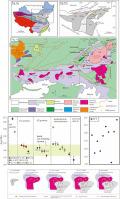当前位置:
X-MOL 学术
›
Ore Geol. Rev.
›
论文详情
Our official English website, www.x-mol.net, welcomes your feedback! (Note: you will need to create a separate account there.)
Timing of multiple magma events and duration of the hydrothermal system at the Yu’erya gold deposit, eastern Hebei Province, China: constraints from U–Pb and Ar–Ar dating
Ore Geology Reviews ( IF 3.3 ) Pub Date : 2020-12-01 , DOI: 10.1016/j.oregeorev.2020.103804 Tao Zhang , Dehui Zhang , Leonid V. Danyushevsky , Mingqian Wu , N'dri Koffi Alexis , Yuzhong Liao , Jilin Zhang
Ore Geology Reviews ( IF 3.3 ) Pub Date : 2020-12-01 , DOI: 10.1016/j.oregeorev.2020.103804 Tao Zhang , Dehui Zhang , Leonid V. Danyushevsky , Mingqian Wu , N'dri Koffi Alexis , Yuzhong Liao , Jilin Zhang

|
Abstract The Yu’erya deposit is a large granite–hosted gold deposit in the eastern Hebei Province classified as an intrusion–related gold system. The Yu’erya complex contains the causative intrusion which was the source of hydrothermal metal-bearing fluids. This composite granite complex contains miarolitic pegmatite(–like) cavities and pegmatite veins. A combination of detailed field observations and U–Pb dating by SHRIMP and LA–ICP–MS is used to document multiple magmatic events which occurred at 210–220, 175–173, 171–170, 167–166 and ~161 Ma formed the Yu’erya granite complex. The initiation of the hydrothermal system, as determined via Ar–Ar dating, is closely related to the exsolution of a magmatic volatile phase from the G1 granite at ca.176 Ma. The hydrothermal system operated for ~16 my (176–160 Ma) and produced multiple mineralising events (~176, 172–168 and 162–160 Ma) linked to emplacement of repeated magma pulses from 175 Ma to 161 Ma. Our results suggest that multiple magmatic–hydrothermal events over a time period of several million years may be a fundamental factor responsible for the enrichment process during formation of intrusion-related gold deposits and thus may be a requirement for forming economic orebodies.
更新日期:2020-12-01



























 京公网安备 11010802027423号
京公网安备 11010802027423号